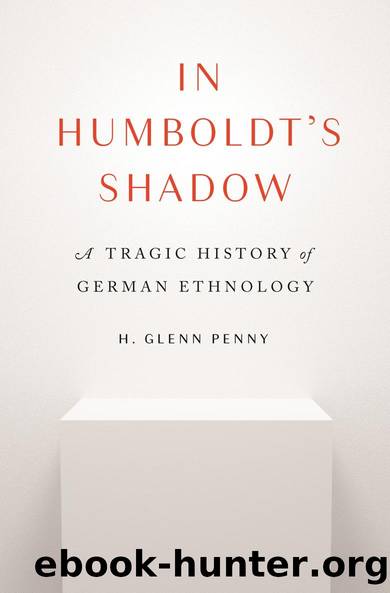In Humboldt's Shadow by H. Glenn Penny

Author:H. Glenn Penny [Penny, H. Glenn]
Language: eng
Format: epub
Tags: Social Science, Anthropology, General, Indigenous Studies, History, Europe, Germany, Social History, Art, Museum Studies
ISBN: 9780691216454
Google: BLEPEAAAQBAJ
Publisher: Princeton University Press
Published: 2021-06-15T04:36:04+00:00
CHAPTER FOUR
Guatemalan Textiles
PERSISTING GLOBAL NETWORKS
A SMALL METAL BOX sits proudly today in the MARKK: Museum am Rothenbaum: World Cultures and Arts (formerly the Hamburgisches Museum für Völkerkunde). The box is filled with cards labeled âThe Elmenhorst Collection of Maya Textiles.â Each card represents an object in that collection, and each holds details, written in English. That information is divided into clear categories: specimen number, acquisition date, object type, size, material, weaving technique, village name, group (tribe or ethnic division), design and color, and âremarks,â which generally include how and when the item was acquired and how it was used. Many cards also include the name of the person who produced the item, a detail often difficult to obtain. The man who created this exactingly documented collection between the 1930s and the 1980s was neither English nor an ethnologist. Carlos W. Elmenhorst was a German who spent most of his adult life in Guatemala. He was a businessman, an entrepreneur who exported coffee, honey, and wax. In his spare time, he created an impressive collection of more than 1,300 Guatemalan textiles. In 1989, he donated that collection to the Hamburgisches Museum für Völkerkunde, not to the Museum für Völkerkunde in Berlin.
The reason is simple: not all roads lead to Berlin. They never did. As Bastian built his museum and pursued his vision, he engaged in keen competition with other German and non-German museums. At the same time, all of those institutions and the ethnologists in them believed they were engaged in a joint project. So, they also cooperated: they exchanged doubles from their collections, they trained and employed one anotherâs assistants, and they launched jointly sponsored expeditions to Africa, Asia, South America, the South Seas and other parts of the world that were underrepresented in their collections. By Bastianâs death in 1905, there were many more museums in Germany than when his celebrated new museum building opened in 1886: large museums were set up in Hamburg, Leipzig, Munich, Stuttgart, and Vienna, and over the decades smaller museums appeared in Basel, Bremen, Cologne, Darmstadt, Dresden, Frankfurt, Freiburg im Breisgau, Herrnhut, Heidelberg, Kassel, Kiel, Karlsruhe, and Lübeck. There were thus many more competitors for objects by the 1920s, and many more museum directors building on Bastianâs transnational networks. He trained them well.
FIGURE 4.1. The box.
Download
This site does not store any files on its server. We only index and link to content provided by other sites. Please contact the content providers to delete copyright contents if any and email us, we'll remove relevant links or contents immediately.
Cecilia; Or, Memoirs of an Heiress — Volume 1 by Fanny Burney(32438)
Cecilia; Or, Memoirs of an Heiress — Volume 2 by Fanny Burney(31875)
Cecilia; Or, Memoirs of an Heiress — Volume 3 by Fanny Burney(31858)
The Great Music City by Andrea Baker(31516)
We're Going to Need More Wine by Gabrielle Union(18972)
All the Missing Girls by Megan Miranda(15590)
Pimp by Iceberg Slim(14398)
Bombshells: Glamour Girls of a Lifetime by Sullivan Steve(13978)
Talking to Strangers by Malcolm Gladwell(13232)
Norse Mythology by Gaiman Neil(13211)
Fifty Shades Freed by E L James(13162)
For the Love of Europe by Rick Steves(13093)
Mindhunter: Inside the FBI's Elite Serial Crime Unit by John E. Douglas & Mark Olshaker(9206)
Crazy Rich Asians by Kevin Kwan(9171)
The Lost Art of Listening by Michael P. Nichols(7411)
Enlightenment Now: The Case for Reason, Science, Humanism, and Progress by Steven Pinker(7240)
The Four Agreements by Don Miguel Ruiz(6637)
Bad Blood by John Carreyrou(6558)
Weapons of Math Destruction by Cathy O'Neil(6149)
